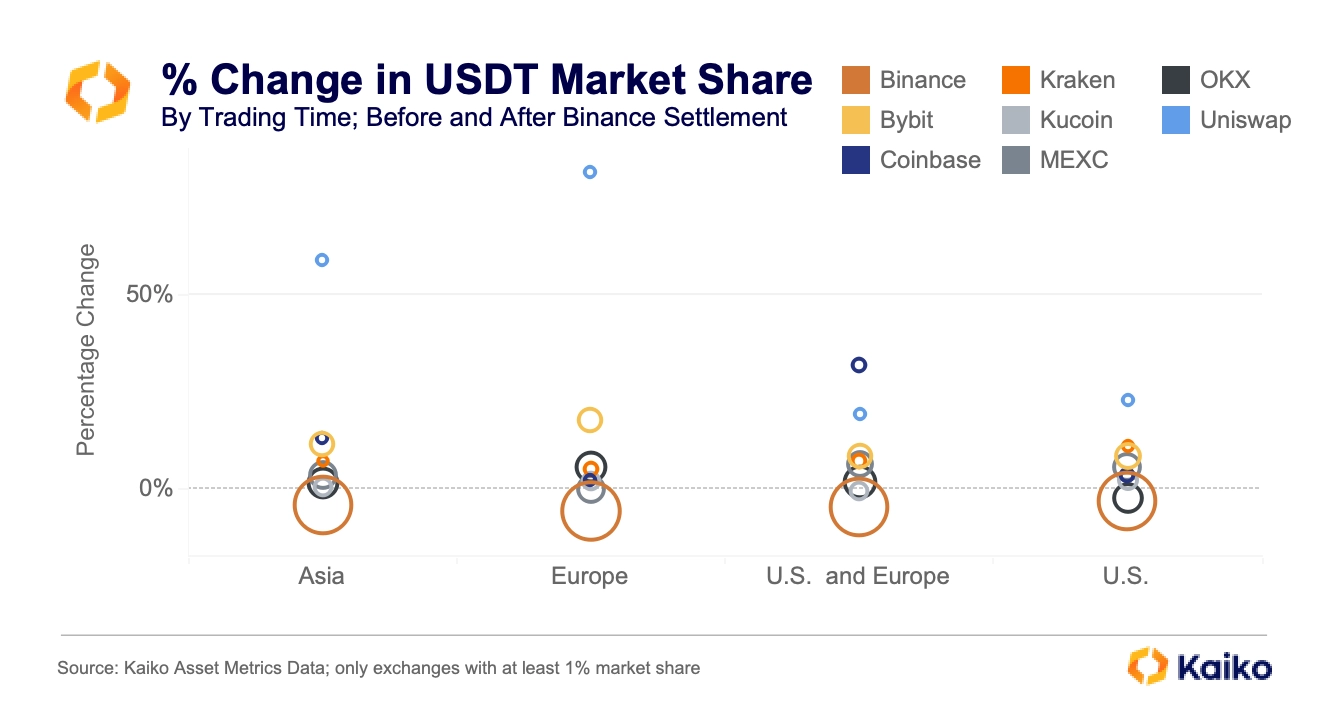

Written by Riyad Carey, Kaiko
Last week, we explored how bitcoin’s center of gravity may be shifting in the wake of Binance’s settlement with the DOJ. This week, we’ll expand the scope of this investigation, exploring how market share is migrating across stablecoins and trading hours.
First, we’ll start with USDT, still by far the most heavily traded stablecoin. The below chart uses Kaiko’s Asset Metrics, meaning that it aggregates the USD volume of all instruments that include USDT, whether USDT-USDC on Curve or SOL-USDT on Binance. It shows the percentage change in each exchange’s market share, so if an exchange expanded from 1% to 2%, the chart would show 100% growth.
The chart also splits market share by trading sessions, with the U.S. and Europe overlap group being the shortest by number of hours but the highest by average trading volume per hour. Finally, the size of each circle represents the exchange’s market share during that session. Note that I’ve excluded exchanges with suspicious trading volumes.

Binance’s USDT market share has fallen 5% across all trading sessions, with the smallest drop coming during U.S. hours. Uniswap has been the biggest winner, growing its USDT market share by more than 50% during Asia and Europe’s trading sessions.
Other changes have been less dramatic. As discussed last week, Bybit continues to perform well, growing the most during Europe’s trading session. Even still, OKX remains the second largest USDT market during all trading sessions. MEXC consistently comes in third, benefitting from its ongoing zero-fee spot trading.
Meanwhile, USD market share shows a similar trend, with its top players – Coinbase and Kraken – ceding market share to smaller exchanges.

LMAX has grown its market share at least 40% in all but the Asia session, while Bitfinex has posted similar gains in all but the U.S. and Europe overlap session. Bitstamp has also gained market share across all sessions.
However, the most interesting trends are related to USDC volume, again involving Uniswap and Bybit. Since Binance’s settlement, both Binance and Uniswap have ceded significant USDC market share to Bybit.

Bybit grew its already substantial USDC market share more than 40% during U.S. hours, and more than 20% during all other hours. Uniswap’s share has fallen more than 35% in all sessions, except for Europe, where it dropped 20%.
Upon further investigation, this is the continuation of a previously unnoticed trend that began early this year. Bybit’s weekly USDC volume began to increase just before USDC’s depeg in March and has continued on this path ever since.

Bybit first passed Uniswap V3 as the highest volume USDC market in June, and since then it has had higher volumes than Uniswap in each week, except for the week of November 5. In just three weeks this winter, Bybit’s weekly USDC volume doubled, from $3bn to $6bn.
CONCLUSION
As we established last week, Bybit has been one of the fastest growing exchanges as measured by spot volume. However, this trend is even more interesting when taking a closer look at volume by stablecoins. Since the start of November, Bybit has had $25bn of USDC trading and $41bn of USDT trading. This split is unprecedented for non-Coinbase exchanges, and even Coinbase itself no longer denominates pairs in USDC, instead opting for unified USD/USDC order books. For the past few years, it seemed probable that USDC would cede CEX market share while capturing DEX trading. In an unlikely turn of events, the fastest growing exchange now does nearly 40% of its trading in USDC. Many reasons have been offered to explain USDC’s bleeding market cap, but Bybit’s newfound dominance could help it reverse the trend.